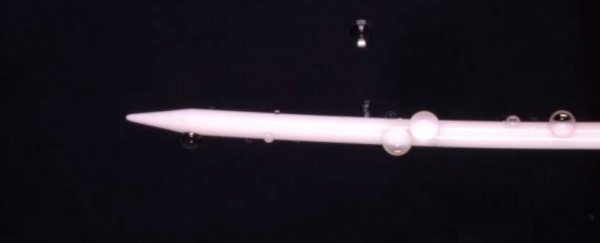This incredible GIF of a water droplet orbiting a knitting needle like a tiny planet has gone nuts on Reddit over the weekend with a lot of "WTF is this sorcery?!" comments. But the science behind how it works is actually even cooler than the footage itself… if that's possible.
This experiment was performed back in 2012 by astronaut Don Pettit on board the International Space Station (ISS) as part of NASA's Science off the Sphere series. And although the set-up may look a lot like a strangely shaped planetary system, the physics here is a little different, because it's the effect of static electric forces, rather than gravitational pull, that's keeping the droplets in orbit.
So let's break down what's going. To start with, Pettit first rubs his polyethylene knitting needle with paper to give it charge. He then uses a teflon-tipped syringe to put pipette out some tiny droplets of water, and they begin to orbit in a strange spiral pattern around the knitting needle. (Someone online was kind enough to map the trajectory of the droplets orbit for us.)
Why does this happen? The fact that Pettit is in the microgravity environment of the ISS obviously plays a large part in this experiment, because the droplets aren't pulled to the ground by gravity like they would be here on Earth. But what's also happening is that the charge of the knitting needle exerts a potential field around it.
The water droplets ejected from the needle are also charged, and this makes them attracted to the needle. But because the drops have some velocity when they're siphoned out, they more often than not orbit around the knitting needle instead of sticking right to it.
You can see Pettit perform the full experiment below with a fascinating explanation of the physics involved, and find out what happens when he mixes things up and uses a teflon knitting needle instead.
Why all the knitting needles in space, you might ask? It turns out, these experiments are actually fantastic simple models and demonstrations not just for what happens when a satellite orbits a planet, but also for when charged solar particles hit Earth's magnetic field.

The cool part is that even though we can't perform the same trick here on Earth thanks to the effect of gravity, you can actually still see the same forces in action at home by rubbing a plastic cup and then holding it close to a stream of tap water, as Veritasium demonstrates around the 1:45 mark in the video below. Happy science-ing!

